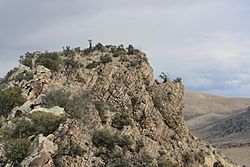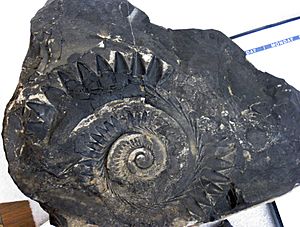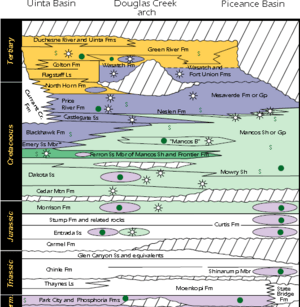Phosphoria Formation facts for kids
Quick facts for kids Phosphoria FormationStratigraphic range: Early Permian |
|
|---|---|

An outcrop of the Phosphoria Formation near the Big Hole River in western Montana.
|
|
| Type | Geological formation |
| Underlies | Dinwoody Formation |
| Overlies | Casper Formation, Park City Formation, Tensleep Sandstone |
| Area | 350,000 sq. km (140,000 sq. mi) |
| Thickness | Up to 420 metres (1,380 ft) |
| Lithology | |
| Primary | Limestone, dolomite, shale |
| Other | Chert, phosphorite, sandstone |
| Location | |
| Region | Idaho, Montana, Utah, Wyoming |
| Country | |
| Type section | |
| Named for | Phosphoria Gulch, Idaho |
| Named by | Richards and Mansfield, 1912 |
The Phosphoria Formation is a special layer of rock found in the western United States. It formed during the Early Permian period, about 299 to 252 million years ago. This rock layer was created over about 15 million years as sediments piled up.
The Phosphoria Formation can be as thick as 420 meters (about 1,378 feet). It spreads out over a huge area of 350,000 square kilometers (about 135,000 square miles). This formation is important because it contains valuable materials like phosphorus and petroleum.
Contents
How the Phosphoria Formation Formed
The Phosphoria Formation was laid down in the ocean. This ocean was located between the ancient North American continent and the edge of the land. Cold, nutrient-rich water from the deep ocean rose to the surface. This process is called "upwelling."
The upwelling water helped tiny ocean creatures like plankton grow a lot. When these creatures died, their bodies sank to the seafloor. Over time, this organic material built up. Not much sand or other rock particles were settling at the same time. This helped create rocks rich in phosphate and hydrocarbons (which make oil and gas).
The formation also has higher levels of certain elements. These include cadmium, chromium, copper, fluorine, molybdenum, nickel, rare earth elements, selenium, uranium, vanadium, and zinc.
Layers of the Phosphoria Formation
The Phosphoria Formation is made of several different layers, like a layered cake. Geologists study these layers from top to bottom.
- The Tosi chert member: This top layer is mostly chert, a hard, fine-grained rock. It has some limestone at its base.
- The Retort phosphatic member: This layer contains phosphorite, which is rich in phosphorus. It also has dolomite and siltstone.
- The Rex chert member: This layer is made of black chert and black cherty shale. It has gray limestone at its bottom.
- The Meade Peak phosphatic member: This is a mix of brown to black shale, gray limestone, and dark brown oolitic phosphorite. It also has a small amount of white calcareous sandstone.
- The Lower Chert member: This bottom layer is made of dark cherty shale.
The Phosphoria Formation sits on top of older rock layers. These include the Casper Formation, the Park City Formation, or the Tensleep Sandstone. It is covered by a younger rock layer called the Dinwoody Formation. Scientists know where the Phosphoria Formation begins and ends. Its top is just below the tan siltstone of the Dinwoody formation. Its bottom is marked by a thin phosphorite layer with many fish scales and bones.
Where the Phosphoria Formation is Found
The Phosphoria Formation is thickest in the Sublett Range in southern Idaho. In this area, it starts with a phosphorite layer. Above that is a thick section of chert and cherty sandstone.
As you move east into western Wyoming, the Phosphoria Formation gets thinner. It mixes with other rock layers like the Park City Formation (made of carbonate rocks) and the Chugwater Formation (made of redbed sandstones). The Phosphoria layers also reach into the Wind River Range and end in the Green Mountains to the east.
Ancient Life in the Phosphoria Formation

Scientists have found many fossils in the Phosphoria Formation. These include brachiopods (shellfish), sponge spicules (parts of sponges), crinoid stems (parts of sea lilies), and tiny tooth-like fossils called conodont elements. They have also found fish scales and bones.
One of the most exciting finds is the "tooth whorls" of an ancient shark called Helicoprion. These sharks had a unique spiral arrangement of teeth. Most of the known Helicoprion tooth whorls come from this formation. One rare fossil even includes parts of the shark's skull! The age of the formation is mainly determined by studying these conodont fossils.
Valuable Resources from the Phosphoria Formation


The Phosphoria Formation is a source of several important natural resources.
Phosphorus
The phosphorite layers in the Phosphoria Formation are mined for phosphorus. This element is mainly used to make fertilizer for crops. Mining for phosphorus happens in southeastern Idaho, northern Utah, western Wyoming, and southwestern Montana.
Uranium
The phosphorite beds also contain small amounts of uranium. However, there isn't enough uranium to make it profitable to mine just for that.
Vanadium
In some parts of western Wyoming and southeastern Idaho, there's a zone rich in vanadium. This element could be valuable in certain areas.
Petroleum
Petroleum (oil) has been found and produced from some of the dolomite layers in the Phosphoria Formation. Many of the shale layers in the formation are also rich in organic matter. This means they are "source rocks" that can create petroleum.


